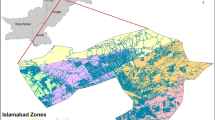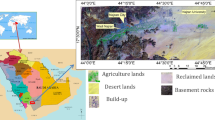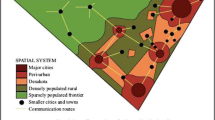Abstract
Since the industrial revolution, rapid urban sprawl has been one of the main characteristics of urbanised areas worldwide. The main objective of this study was to detect, quantify and characterise the changes in land use/land cover (LULC) in Istanbul Province between 2003 and 2015 using a hybrid geographic information systems (GIS)-remote sensing method. Landsat Thematic Mapper and operational land imager images were co-registered and classified using object-based image classification techniques and visual analysis. Land cover maps were rasterized at the same spatial resolution (30 m) in a GIS environment and the same legend was used for both land cover maps. Urbanised areas and other LULC types were determined for the years 2003 and 2015. The extent and spatial distribution of a number of LULC classes in Istanbul changed between 2003 and 2015. Settlement areas increased by 20,464.1 ha in only 12 years and 2529.89 ha of forested land was destroyed for construction of a new highway. Moreover, forests and agricultural areas became highly fragmented. This study confirms the accuracy of the hybrid GIS-remote sensing method. Moreover, the resulting data highlights the extent of the recent rapid land degradation in Istanbul and calls attention to the importance of protecting the natural ecosystems in this area.




Similar content being viewed by others
References
Monela, G., & Solberg, B. (1998). Deforestation rate and land use/land cover changes in rainforest of the Nguru mountains, Tanzania. Faculty of Forest Record, 68, 14. (Sokoine University of Agriculture, Morogoro, Tanzania).
Estoque, R. C., & Murayama, Y. (2011). Spatio-temporal urban land use/cover change analysis in a hill station: The case of Baguio City, Philippines. Procedia Social and Behavioral Sciences, 21, 326–335.
Braimoh, K. A., & Onishi, T. (2007). Spatial determinants of urban land use change in Lagos, Nigeria. Land Use Policy, 24, 502–515.
Foody, G. M. (2001). Monitoring the magnitude of land-cover change around the southern limits of Sahara. Photogrammetric Engineering and Remote Sensing, 56(11), 1515–1522.
Lambin, E. F., Rounsevell, M. D. A., Geist, H. J., et al. (2000). Are agricultural land-use modelsable to predict changes in land-use intensity? Agriculture, Ecosystems and Environment, 82, 321–331.
Cihlar, J., & Jansen, L. J. M. (2001). From land cover to land-use: A methodology for efficient land-use mapping over large areas. The Professional Geographer, 53(2), 275–289.
Slayback, D. (2003). Landcover change in the Takamanda forest reserve, Cameroon: 1986–2000. In J. A. Chomiskey & T. C. H. Sunderland’s (Eds.), Takamanda: The biodiversity of an African rainforest. Washington, DC: Smithsonian Institution. (SI/MAB Series #8).
Turner, M. D. (2003). Environmental science and social causation in the analysis of Sahelian pastoralism. In K. S. Zimmerer & T. J. Basset’s (Eds.), Political ecology: An integrative approach to geography and environment-development studies. New York: Guilford Press.
DeVries, B., Decuyper, M., Verbesselt, J., Zeileis, A., Herold, M., Joseph, S., et al. (2015). Tracking disturbance-regrowth dynamics in tropical forests using structural change detection and Landsat time series. Remote Sensing of Environment, 169, 320–334.
Kabba, V. T. S., & Li, J. (2011). Analysis of land use and land cover changes and their ecological implications in Wuhan, China. Journal of Geography and Geology, 3, 1.
Kashaigili, J. J., & Majaliwa, A. M. (2010). Integrated assessment of land use and cover changes in the Malagarasi river catchment in Tanzania. Physics and Chemistry of the Earth, 35(730), 741.
Hermosilla, T., Wulder, M. A., White, J. C., Coops, N. C., Hobart, G. W., et al. (2015). Regional detection, characterization, and attribution of annual forest change from 1984 to 2012 using Landsat-derived time-series metrics. Remote Sensing of Environment, 170, 121–132.
Rokni, K., Ahmad, A., Solaimani, K., Hazini, S., et al. (2015). A new approach for surface water change detection: Integration of pixel level image fusion and image classification techniques. International Journal of Applied Earth Observation and Geoinformation, 34, 226–234.
De Beurs, K. M., Henebry, G. M., Owsley, B. C., Sokolik, I., et al. (2015). Using multiple remote sensing perspectives to identify and attribute land surface dynamics in Central Asia 2001–2013. Remote Sensing of Environment, 170, 48–61.
Bouchaffra, D., Cheriet, M., Jodoin, P. M., Beck, D., et al. (2015). Machine learning and pattern recognition models in change detection. Pattern Recognition, 48, 613–615.
Dewan, M. A., & Yamaguchi, Y. (2009). Using remote sensing and GIS to detect and monitor land use and land cover change in Dhaka Metropolitan on Bangladesh during 1960–2005. Environmental Monitoring and Assessment, 150, 237–249.
Wan, L., Zhang, Y., Qi, S., Na, X., et al. (2015). Comparison of land use/land cover change and landscape patterns in Honghe National Nature Reserve and the surrounding Jiansanjiang Region, China. Ecological Indicators, 51, 205–214.
Van de Voorde, T., van der Kwast, J., Poelmans, L., Canters, F., Binard, M., Cornet, Y., et al. (2016). Projecting alternative urban growth patterns: The development and application of a remote sensing assisted calibration framework for the Greater Dublin Area. Ecological Indicators, 60, 1056–1069.
Elbeih, S. F., & Soliman, N. M. A. (2015). An approach to locate and map swelling soils around Sohag—Safaga road, Eastern Desert, Egypt using remote sensing techniques for urban development. The Egyptian Journal of Remote Sensing and Space Science, 18(1), 31–41. (supplement 1).
Willis, K. S. (2015). Remote sensing change detection for ecological monitoring in United States protected areas. Biological Conservation, 182, 233–242.
Gandhi, G. M., Parthiban, S., Thummalu, N., Christy, A., et al. (2015). NDVI: Vegetation change detection using remote sensing and GIS—a case study of Vellore District. Procedia Computer Science, 57, 1199–1210.
Motohka, T., Shimada, M., Uryu, Y., Setiabudi, B., et al. (2014). Using time series PALSAR gamma nought mosaics for automatic detection of tropical deforestation: A test study in Riau, Indonesia. Remote Sensing of Environment, 155, 79–88.
Reiche, J., Verbesselt, J., Hoekman, D., Herold, M., et al. (2015). Fusing Landsat and SAR time series to detect deforestation in the tropics. Remote Sensing of Environment, 156, 276–293.
Sun, D. (2015). Detection of dryland degradation using Landsat spectral unmixing remote sensing with syndrome concept in Minqin County, China. International Journal of Applied Earth Observation and Geoinformation, 41, 34–45.
Soto, I. M., Cannizzaro, J., Muller-Karger, F. E., Hu, C., Wolny, J., Goldgof, D., et al. (2015). Evaluation and optimization of remote sensing techniques for detection of Karenia brevis blooms on the West Florida Shelf. Remote Sensing of Environment, 170, 239–254.
Jensen, J. R. (1996). Introductory digital image processing: A remote sensing perspective (2nd ed., p. 316). New York: Prentice Hall.
Volpi, M., Tuia, D., Bovolo, F., Kanevski, M., Bruzzone, L., et al. (2013). Supervised change detection in VHR images using contextual information and support vector machines. International Journal of Applied Earth Observation and Geoinformation, 20, 77–85.
Hussain, M., Chen, D., Cheng, D., Wei, H., Stanley, D., et al. (2013). Change detection from remotely sensed images: From pixel-based to object-based approaches. ISPRS Journal of Photogrammetry and Remote Sensing, 80, 91–106.
Fan, J., Zhang, J., Mei, K., Peng, J., Gao, L., et al. (2015). Cost-sensitive learning of hierarchical tree classifiers for large-scale image classification and novel category detection. Pattern Recognition, 48, 1673–1687.
Xiaolu, S., & Bo, C. (2011). Change detection using change vector analysis from Landsat TM images in Wuhan. Procedia Environmental Sciences, 11, 238–244.
Pekel, J. F., Vancutsem, C., Bastin, L., Clerici, M., Vanbogaert, E., Bartholomé, E., et al. (2014). A near real-time water surface detection method based on HSV transformation of MODIS multi-spectral time series data. Remote Sensing of Environment, 140, 704–716.
Zhang, Z., Chen, H., Xu, Y., Zhong, J., Lv, N., Chen, S., et al. (2015). Multisensor-based real-time quality monitoring by means of feature extraction, selection and modeling for Al alloy in arc welding. Mechanical Systems and Signal Processing, 60–61, 151–165.
Yang, X. T., Liu, H., Gao, X., et al. (2015). Land cover changed object detection in remote sensing data with medium spatial resolution. International Journal of Applied Earth Observation and Geoinformation, 38, 129–137.
Gärtner, P., Förster, M., Kurban, A., Kleinschmit, B., et al. (2014). Object based change detection of Central Asian Tugai vegetation with very high spatial resolution satellite imagery. International Journal of Applied Earth Observation and Geoinformation, 31, 110–121.
Taha, L. G. E. (2014). Assessment of urbanization encroachment over Al-Monib island using fuzzy post classification comparison and urbanization metrics. The Egyptian Journal of Remote Sensing and Space Science, 17, 135–147.
Colditz, R. R., Acosta-Velázquez, J., Díaz Gallegos, J. R., Vázquez Lule, A. D., Rodríguez-Zúñiga, M. T., Maeda, P., et al. (2012). Potential effects in multi-resolution post-classification change detection. International Journal of Remote Sensing, 33, 6426–6445.
Teng, S. P., Chen, Y. K., Cheng, K. S., Lo, H. C., et al. (2008). Hypothesis-test-based landcover change detection using multi-temporal satellite images—a comparative study. Advances in Space Research, 41, 1744–1754.
Turkish Statistical Institute (TUIK), 2016. Address based population registration system results. Accessed February 25, 2015, http://tuikapp.tuik.gov.tr/adnksdagitapp/adnks.zul?dil=2.
Istanbul Metropolitan Municipality (IMM), 2015. Geographical and strategic position of Istanbul. Accessed September 11, 2015, http://www.ibb.gov.tr/sites/ks/en-US/0-Exploring-The-City/Location/Pages/GeographicalandStrategicPosition.aspx.
Turkish State Meteorological Service (TSMS), 2015. Annual total precipitation data of Istanbul. Accessed September 11, 2015, http://www.mgm.gov.tr/veridegerlendirme/yillik-toplam-yagis-verileri.aspx?m=istanbul#sfB.
Mas, J. F. (1999). Monitoring land-cover changes: A comparison of change detection techniques. International Journal of Remote Sensing, 20(1), 139–152.
Hexagon Geospatial, (2016). Radiometric enhancement, histogram matching. Accessed February 24, 2016, https://wiki.hexagongeospatial.com//index.php?title=Radiometric_Enhancement.
USGS (United States Geological Survey), 2015a. Band designations for the Landsat satellites. Accessed August 15, 2015, http://landsat.usgs.gov/band_designations_landsat_satellites.php.
Song, C., Woodcock, C. E., Seto, K. C., Lenney, M. P., Macomber, S. A., et al. (2001). Classification and change detection using Landsat TM data: When and how to correct atmospheric effects? Remote Sensing of Environment, 75, 230–244.
Jensen, J. R. (1983). Urban/suburban land use analysis. Manual Remote Sensing, 2, 1571–1666.
Makkaesorn, A., Chang, N.-B., Li, J., et al. (2009). Seasonal change detection of riparian zones with remote sensing images and genetic programming in a semi-arid watershed. Journal of Environmental Management, 90, 1069–1080.
Mei, A., Manzo, C., Fontinovo, G., Bassani, C., Allegrini, A., Petracchini, F., et al. (2015). Assessment of land cover changes in Lampedusa Island (Italy) using Landsat TM and OLI data. Journal of African Earth Sciences, 122, 15–24.
El-Asmar, H. M., Hereher, M. E., El Kafrawy, S. B., et al. (2013). Surface area change detection of the Burullus Lagoon, North of the Nile Delta, Egypt, using water indices: A remote sensing approach. The Egyptian Journal of Remote Sensing and Space Science, 16, 119–123.
Lillesand, T., Kiefer, R., Chipman, J., et al. (2004). Remote sensing and image interpretation (5th ed.). New York: Wiley.
Baatz, M., & Schaepe, A. (2000). Multi resolution segmentation: An optimization approach for high quality multi-scale image segmentation. In J. Strobl & T. Blaschke (Eds.), Angewandte geographische informations verarbeitung (Vol. XII, pp. 12–23). Heidelberg: Wichmann.
Definiens (2003). Definiens imaging, eCognition. Resource document. Harris Geospatial. Accessed September 12 , 2015, http://www.definiens-imaging.com.
Forghani, A., Cechet, B., Nadimpalli, K., et al. (2007). Object-based classification of multi-sensor optical imagery to generate terrain surface roughness information for input to wind risk simulation. In IEEE international geoscience and remote sensing symposium, IGARSS 2007, Barcelona.
USGS (United States Geological Survey), 2015b. NLCD 92 land cover class definitions. Accessed September 12, 2015, http://landcover.usgs.gov/classes.php.
Jensen, J. R. (2005). Introductory digital image processing: A remote sensing perspective (3rd ed.). New Jersey: Pearson Education Inc.
Zhan, X., Sohlber, R. A., Townshend, J. R. G., DiMiceli, C., Carroll, M. L., Eastman, J. C., et al. (2002). Detection of land cover changes using MODIS 250 m data. Remote Sensing of Environment, 83, 336–350.
Grinblat, G. L., Uzal, L. C., Granitto, P. M., et al. (2013). Abrupt change detection with one-class time-adaptive support vector machines. Expert Systems with Applications, 40, 7242–7249.
Ngo, L. T., Mai, D. S., Pedrycz, W., et al. (2015). Semi-supervising interval Type-2 Fuzzy C-Means clustering with spatial information for multi-spectral satellite image classification and change detection. Computers and Geosciences, 83, 1–16.
Afify, H. A. (2011). Evaluation of change detection techniques for monitoring land-cover changes: A case study in new Burg El-Arab area. Alexandria Engineering Journal, 50, 187–195.
Kleynhans, W., Salmon, B. P., Olivier, J. C., et al. (2015). Detecting settlement expansion in South Africa using a hyper-temporal SAR change detection approach. International Journal of Applied Earth Observation and Geoinformation, 42, 142–149.
Singh, A. (1989). Review article digital change detection techniques using remotely sensed data. International Journal of Remote Sensing, 10(6), 989–1003.
Lê, T. T., Atto, A. M., Trouvé, E., Solikhin, A., Pinel, V., et al. (2015). Change detection matrix for multitemporal filtering and change analysis of SAR and PolSAR image time series. ISPRS Journal of Photogrammetry and Remote Sensing, 107, 64–76.
Qi, Z., Yeh, A. G.-O., Li, X., Zhang, X., et al. (2015). A three-component method for timely detection of land cover changes using polarimetric SAR images. ISPRS Journal of Photogrammetry and Remote Sensing, 107, 3–21.
Biging, G. S., Colby, D. R., & Congalton, R. G. (1998). Sampling systems for change detection accuracy assessment. In R. S. Lunetta & C. D. Elvidge (Eds.), Remote sensing change detection: Environmental monitoring methods and applications (pp. 281–308). Chelsea, Michigan: Sleeping Bear Press.
Van Oort, P. A. J. (2007). Interpreting change detection error matrix. Remote Sensing of Environment, 108, 1–8.
Fitzpatrick-Lins, K. (1981). Comparison of sampling procedures and data analysis for a land-use and lond-cover map. Photogrammetric Engineering and Remote Sensing, 47(3), 343–351.
Yuan, F., Sawaya, K. E., Loeffelholz, B. C., & Bauer, M. E. (2015). Land cover classification and change analysis of the Twin Cities (Minnesota) metropolitan area by multitemporal Landsat remote sensing. Remote Sensing of Environment, 98, 317–328.
Author information
Authors and Affiliations
Corresponding author
Rights and permissions
About this article
Cite this article
Kara, F., Keçeli, A. Impact of rapid urbanisation on land cover in Istanbul Province. Spat. Inf. Res. 25, 293–302 (2017). https://doi.org/10.1007/s41324-017-0100-z
Received:
Revised:
Accepted:
Published:
Issue Date:
DOI: https://doi.org/10.1007/s41324-017-0100-z




